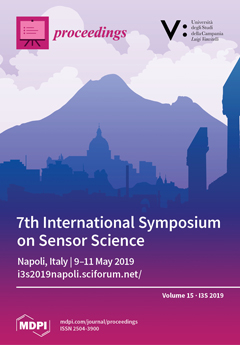Need Help?
Proceedings, 2019, I3S 2019
7th International Symposium on Sensor Science
Napoli, Italy | 9–11 May 2019
Issue Editors:
Luigi Zeni, University of Campania Luigi Vanvitelli, Italy
Nunzio Cennamo, University of Campania Luigi Vanvitelli, Italy
Aldo Minardo, University of Campania Luigi Vanvitelli, Italy
- Issues are regarded as officially published after their release is announced to the table of contents alert mailing list.
- You may sign up for e-mail alerts to receive table of contents of newly released issues.
- PDF is the official format for papers published in both, html and pdf forms. To view the papers in pdf format, click on the "PDF Full-text" link, and use the free Adobe Reader to open them.
Cover Story (view full-size image):
Sensor's technology has shown to be suitable for applications in many important fields, including pharmaceutical researches, medical diagnostics, environmental monitoring, industrial applications,
[...] Read more.
Sensor's technology has shown to be suitable for applications in many important fields, including pharmaceutical researches, medical diagnostics, environmental monitoring, industrial applications, food safety and security. Sensor's technology represents the ideal field to foster the development of innovative applications, measurement schemes and strategies, comprising the exploitation of transducers, smart materials, receptors, nanostructures and so on. This international conference, supported by the journal Sensors, has brought together scientists from different areas to discuss important recent developments in sensor's technology. The Conference has been an opportunity to meet an interdisciplinary community willing to discuss on important breakthroughs in sensor's technology and related fields.
Previous Issue
Next Issue
Issue View Metrics
Multiple requests from the same IP address are counted as one view.



